Galileo’s moon drawings

From an analysis of when and where these drawings were done.



This site is made possible by member support. 💞
Big thanks to Arcustech for hosting the site and offering amazing tech support.
When you buy through links on kottke.org, I may earn an affiliate commission. Thanks for supporting the site!
kottke.org. home of fine hypertext products since 1998.
Speaking of the Moon, the LRO snapped a new picture of Apollo 11 landing site from its orbital perch 50km above the surface.

NASA announced that it has found pretty hard evidence of significant amounts of water on the Moon.
“We are ecstatic,” said Anthony Colaprete, LCROSS project scientist and principal investigator at NASA’s Ames Research Center in Moffett Field, Calif. “Multiple lines of evidence show water was present in both the high angle vapor plume and the ejecta curtain created by the LCROSS Centaur impact. The concentration and distribution of water and other substances requires further analysis, but it is safe to say Cabeus holds water.”
I don’t have to tell you about the implications here. Just think of how much you could sell authentic Moon bottled water for.
Nothing like a little science on the Moon, I always say.
Astronaut David Scott in 1971, from the Apollo 15 Lunar Surface Journal. Scott was part of the Apollo 15 crew, and applied Galileo’s findings about gravity and mass by testing a falcon feather and a hammer. The film, shown in countless high school physics classes, is the nerdy, oft-neglected cousin of Neil Armstrong’s space paces.
For those of you who missed the show last night or if you just want a replay, the CBS News footage of the Apollo 11 Moon landing and Moon walk, presented by Walter Cronkite, is available on YouTube. The Moon landing video is here and the first of 7 videos of the Moon walk is here.
Inspired by the ApolloPlus40 Twitter account and We Choose the Moon, both of which are tracking the Apollo 11 mission as it happened 40 years ago, I’ve built a page where you can watch the CBS News coverage of Walter Cronkite reporting on the Moon landing and the first moon walk, 40 years to the second after it originally happened.

Just leave this page open in your browser and at the appointed times (schedule is below), the broadcast will begin (no manual page refresh necessary).
Schedule:
Moon landing broadcast start: 4:10:30 pm EDT on July 20
Moon landing shown: 4:17:40 pm EDT
Moon landing broadcast end: 4:20:15 pm EDT
Moon walk broadcast start: 10:51:27 pm EDT
First step on Moon: 10:56:15 pm EDT
Nixon speaks to the Eagle crew: approx 11:51:30 pm EDT
Moon walk broadcast end: 12:00:30 am EDT on July 21
If you’ve never seen this coverage, I urge you to watch at least the landing segment (~10 min.) and the first 10-20 minutes of the Moon walk. I hope that with the old time TV display and poor YouTube quality, you get a small sense of how someone 40 years ago might have experienced it. I’ve watched the whole thing a couple of times while putting this together and I’m struck by two things: 1) how it’s almost more amazing that hundreds of millions of people watched the first Moon walk *live* on TV than it is that they got to the Moon in the first place, and 2) that pretty much the sole purpose of the Apollo 11 Moon walk was to photograph it and broadcast it live back to Earth.
Thanks to Meg for her JS help…any errors or sloppy code are mine. Please note that schedule times are approximate, based on your computer’s clock, and that the syncing of the videos might not be perfect. You need to have JS and Flash 8+ to view. This is just like real TV…if you miss the appointed time, there’s no rewind or anything…the video is playing “live”. I have not done extensive browser testing so it may not work perfectly in your browser. Bug reports are welcome and I will try to fix things as they crop up. If you run into any problems, just reload the page. To ensure that you have the latest (hopefully bug-free) version before the broadcast begins, reload the page. Other than that, if you leave it open, the broadcast will happen automatically.
Update: If you missed the “live” show, you can watch all of the clips on YouTube.
Update: The Apollo broadcast no longer requires Flash. Big thanks to Geoff Stearns for helping me with the upgrade.
I said yesterday that NASA would be taking some new photos of the Apollo landing sites with the Lunar Reconnaissance Orbiter. Turns out that happened pretty quickly…they just released photos of the Apollo 11, 14, 15, 16, and 17 sites. Here’s the Apollo 11 site:

The lunar module is the small white bit in the middle casting the long shadow. The Apollo 14 site is the coolest…you can see the path the astronauts took out to some scientific instruments. The LRO hasn’t reached its final orbit yet so future images “will have two to three times greater resolution”. !!! See also my giant Apollo 11 post.
Hmm, I was just wondering about this the other day: NASA’s Lunar Reconnaissance Orbiter is going to take photos of some of the Apollo landing sites, including where Apollo 11 landed.
Lunar archaeologists, interested in making the Apollo 11 site a National Historic Landmark, hope the planned photos will answer some of these longstanding questions: What is the condition of Tranquility Base after 40 years? Was the American flag blown over on the Eagle’s ascent and is it now a bleached skeleton? What are the relatively long term effects of the lunar environment on human artifacts?
This should quiet the people who still think it was all a hoax…although NASA could be faking these photos as well.
NASA is restoring and improving the video footage of the Apollo 11 mission and this morning they released some of those videos, including Neil Armstrong’s first step on the Moon, Aldrin’s first step, and the raising of the American flag.
Update: The tapes containing the original footage were erased to record satellite data. The restorations are being sourced from broadcast TV footage.
Today is the 40th anniversary of the liftoff of Apollo 11. You can follow along on We Choose the Moon, on Twitter, and with a NASA audio program. (Is there a video launch being broadcast anywhere?)
NASA is also releasing “greatly improved video imagery” of the Apollo 11 moon walks. !!! So look for that later today.
Update: Someone should have synced up this video footage of the launch so that people could watch it in realtime.
We Choose the Moon is a site that tracks the activities of the Apollo 11 mission as it happened 40 years ago. Nice work. The transmissions from the spacecraft, CAPCOM, and the lunar lander are cleverly published to and pulled in from Twitter.
With all this 40th anniversary stuff, I’m having trouble getting my mind around that the first Moon landing is as far removed from the present as the low point of The Great Depression was from my birth (i.e. the Moon landing, culturally speaking, is Ollie’s Great Depression). See also timeline twins. (via jimray)
HD video of the Moon from 13 miles above the surface taken by Japan’s KAGUYA probe. The probe’s orbit has been decaying since it began circling the Moon and will crash on the surface at 18:30 GMT on June 10.
The Book Cover Archive Blog gets the skinny on using NASA images in creative work.
All of the media produced by NASA is public domain, meaning that anyone can use it any way (as long as they obey restrictions of publicity and privacy).
They also point to NASA Images, which is operated by Internet Archive and contains a copy of almost every image that NASA has ever produced. Just for the heck of it, here’s the first photo of the Moon taken by a US spacecraft.

I am hoping that Moon will be awesome and not just a mashup of 2001 and Solaris. The score is by Clint Mansell, who has scored all of Darren Aronofsky’s movies, most notably Requiem for a Dream. Moon opens on June 12 in NYC and LA. (via sarahnomics)
A zoomable National Geographic map of the Moon from 1969. Richard Furno worked on the map and tells the very long story of how it came about. One of the first images on the page is from a Soviet mission called Luna-3 that took the first photographs of the far side of the Moon. (thx, lynda)
A classic from The Onion in way more than 96 pt. type: HOLY SHIT, MAN WALKS ON FUCKING MOON.
“Holy living fuck…. Are you fucking believing this? Over,” Armstrong radioed back to NASA headquarters nearly 250,000 miles away. “I abso-fucking-lutely am standing on the surface of the fucking moon. I am talking to you from the goddamned fucking moon. Jesus H. Christ in a chicken basket.”
“Holy mother of fuck,” the first man on the moon added.
A photograph of the newest possible moon, one that’s only about 15 hours old.
Finding the Moon when its slim crescent is still less than about 24 hours past the New Moon phase requires careful timing and planning, a challenging project even for experienced observers. In this sighting, only about 0.8 percent of the Moon’s disk appears illuminated.
(via airbag)
A fantastic pair of maps, courtesy of Strange Maps:
- A map of the area covered by Neil Armstrong and Buzz Aldrin on their Apollo 11 moon walks, superimposed on a soccer pitch for comparison purposes.
- The same map, superimposed on a baseball diamond.
Update: Here’s a look at the traverse map overlaid on the moon’s surface.
Update: For all you conspiracy theorists out there, LVHRD superimposed the traverse map onto a Universal Studios soundstage.
Did you know that there’s a teensy museum on the moon?
Now I find out there was already an entire Moon Museum, with drawings by six leading contemporary artists of the day: Andy Warhol, Robert Rauschenberg, David Novros, Forrest “Frosty” Myers, Claes Oldenburg, and John Chamberlain. The Moon Museum was supposedly installed on the moon in 1969 as part of the Apollo 12 mission.
I say supposedly, because NASA has no official record of it; according to Frosty Myers, the artist who initiated the project, the Moon Museum was secretly installed on a hatch on a leg of the Intrepid landing module with the help of an unnamed engineer at the Grumman Corporation after attempts to move the project forward through NASA’s official channels were unsuccessful.
On the origin of the Earth’s moon and how our planet would be different if we didn’t have a moon.
The Moon has been a stabilizing factor for the axis of rotation of the Earth. If you look at Mars, for instance, that planet has wobbled quite dramatically on its axis over time due to the gravitational influence of all the other planets in the solar system. Because of this obliquity change, the ice that is now at the poles on Mars would sometimes drift to the equator. But the Earth’s moon has helped stabilize our planet so that its axis of rotation stays in the same direction. For this reason, we had much less climatic change than if the Earth had been alone. And this has changed the way life evolved on Earth, allowing for the emergence of more complex multi-cellular organisms compared to a planet where drastic climatic change would allow only small, robust organisms to survive.
Earthrise and earthset movies made by Kaguya, a Japanese spacecraft currently orbiting the moon. Also available here at a higher quality. I’m hoping these are available in HD at some point.
William Safire, who now does the On Language column for the NY Times, wrote a speech for President Nixon in 1969 in the event that something happened during the Apollo 11 mission to strand the astronauts on the moon.
Fate has ordained that the men who went to the moon to explore in peace will stay on the moon to rest in peace.
(via cyn-c)
Timelapse animation of the moon going through a full lunar cycle. Wobble wobble wobble wobble. More info here.
Trailer for In the Shadow of the Moon, a documentary that “brings together for the first, and possibly the last, time surviving crew members from every single Apollo mission that flew to the Moon along with visually stunning archival material re-mastered from the original NASA film footage”. BOY HOWDY! Here’s a review of the film from Ad/Astra, the magazine of the National Space Society.
One of NASA’s spacecraft caught a lunar transit of the sun. The movie is a must-see.
Quicktime VR panoramas from the Apollo missions to the moon (with audio). These are fantastic.
Letters to George W. Bush from German citizens attempting to affirm their rights to moon land they have purchased for $19.99 an acre. “If you intend to use my area within the bounds of your intention, to build a moon base or something else on, over, or under the surface of this moon area, you have to contact me personally. This must be absolutely, to clear up under which special conditions I will leave the rights of use to you or the United States of America.”
The issues involved with buying and selling moon dust. Back in 1993, a 200-milligram moon rock was sold for $442,500.
Middle school students in Indiana and Australia are building edible moon rovers, with the idea that if you’re going to ship a car to the moon or Mars, why not have it be edible when you get there?
Google Moon: explore the Apollo landing sites in the Google Maps interface.
Stay Connected